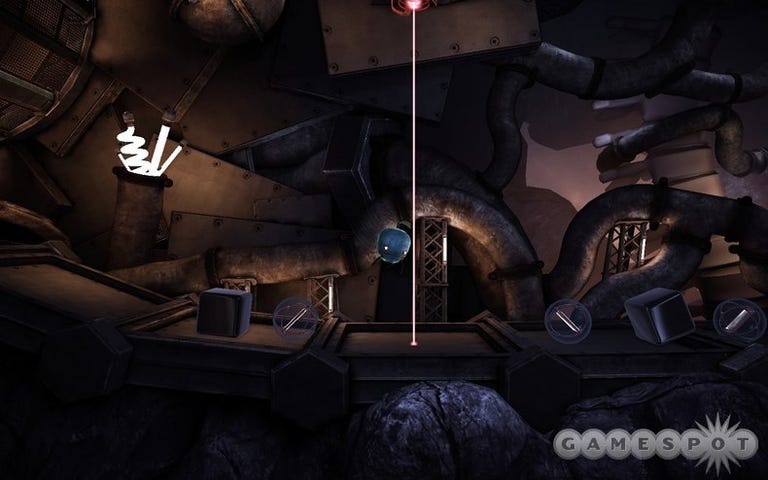In the glut of recent, independent puzzle games, how does any given game distinguish itself from the pack? Don't ask Unmechanical, the newest puzzler from Talawa Games. With its inspiration displayed so clearly on its sleeve, it struggles to stand out. Yet it's still a fun and clever game with slick visuals and varied puzzles, making it a stimulating trifle that will occupy a pleasant afternoon.
The Good
The Bad
The Bottom Line
Unmechanical's story is told entirely through the visual gameplay; there's no text, no dialogue, and very few symbol or pictogram cues. You play as a little robot with a propeller attached to its head, which allows you to fly around the game's levels at will. As the game progresses, you receive upgrades that give you new powers, generally allowing you to traverse new terrain (such as underwater) or interact with physics objects differently.
For the most part, though, you have only one thing you can do: grab stuff. Using a short-range tractor beam, you can pick up rocks, steel girders, flaming balls of death, and mirrors, among other things. Most puzzles involve positioning these things in various ways to solve puzzles and open doors or receive power spheres. The power spheres are used to power Unmechanical's biomechanical devices (many of which look like human organs). Powering these devices unlocks new areas and more puzzles, and reveals, indirectly, the game's backstory.
Unmechanical feels and plays a lot like a combination of http://www.gamespot.com// and http://www.gamespot.com//, if you know those games. If you don't, imagine a standard platformer, add a heavy dose of physics puzzles, take away any combat elements, and tell the story entirely with pictograms. Unfortunately, this last part is where Unmechanical stumbles. Often, the pictograms are confusing or outright unhelpful, and you're likely to find yourself at a loss--not because you can't figure out how to solve a puzzle, but because you simply don't know where to go next or what you're supposed to be doing. Eventually you'll get there by process of elimination, but some indicator arrows or other simplifiers would've reduced some frustration.
The puzzles in the game are, for the most part, excellent amd varied, and do a great job of challenging your noggin without being frustrating. One puzzle requires you to play a put-the-ball-in-the-hole game using a gravity-reversal machine; another requires you to search out the right combination of chemical components by observing the world around you and making deductions. Sure, there's plenty of the standard: press-button-with-heavy-object puzzles or bounce-beam-with-mirrors puzzles, but even these are laid out in a way that won't drive you crazy.
It's impressive how the basic themes of stacking and combining themes remain so fresh, but Unmechanical rarely feels like it's retreading territory. There are a few exceptions to the well-conceived standard, however, particularly with regard to puzzles requiring you to balance objects on each other (where the physics engine gets annoying), but by and large you'll find the puzzles enjoyable and clever.
The puzzle diversity is matched by varied, beautifully rendered levels ranging from dank tunnels to hellish magma caves. While there's little in the way of interaction with "living" things (that is, other characters), you'll appreciate the way the artists play with activity in the background and draw your eye to more than just the puzzle you're working on at a given time. Indeed, art often clues you in as to how best to handle a puzzle. Pictograms don't simply spell out answers, mind you; you must carefully observe visual cues.
One early puzzle, for example, requires you to restore power to a lever that has got a severed, live wire. Below the wire is a large pool of water that undulates when an object from the background falls into it. You can solve the puzzle by dropping more massive objects in it, displacing the water up over the live wire and creating a makeshift connection to restore the lever to functionality. Visuals in Unmechanical are more than just a pretty face.
The rest of the game's features focus on minimalism. Controls are easy with either a gamepad or the keyboard, but all you can do is move or grab stuff anyway. Sound and music are unremarkable but competently handled throughout the game, and the story, such as it is, unfolds bit by bit in a way that keeps you interested if not enthusiastic.
Otherwise, there's not much to tell: Unmechanical is a fun and clever game that treads familiar ground. And yet it's thoughtful enough to inspire your intellect and draw you into its world. You may not miss it once you leave it behind, but Unmechanical is a pleasant puzzler that keeps you busy for the few hours that it lasts.

